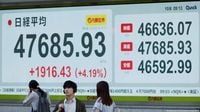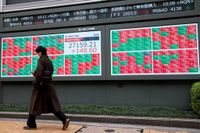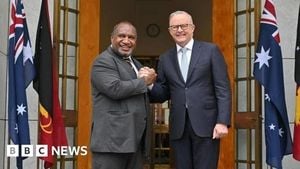Tokyo’s financial district was abuzz on Monday, October 6, 2025, as Japan’s Nikkei 225 index catapulted to a record high, closing at 47,944.76—an extraordinary 4.75% leap that left investors and analysts alike scrambling to keep up. The catalyst for this historic surge? The election of Sanae Takaichi as leader of the country’s ruling Liberal Democratic Party (LDP) just two days prior, positioning her to become Japan’s first female prime minister. Her ascent has not only shaken up the country’s political landscape but also sent ripples through global markets and triggered a dramatic shift in the value of the yen.
According to Bloomberg, Japanese stocks surged and the yen plunged after Takaichi’s decisive victory in the LDP leadership contest on October 4. The Nikkei’s rally was broad-based, with real estate, technology, and heavy industry sectors leading the charge. Yaskawa Electric Corp soared over 20%, Japan Steel Works climbed 14%, and industrial giants like Mitsubishi Heavy Industries and Kawasaki Heavy Industries posted double-digit gains. The Topix index, another key benchmark, rose as much as 3.1% to an all-time high of 3,226.06.
The euphoria was not confined to Japan alone. As CNBC reported, US equity futures also rose on October 5, with investors betting that a resilient global economy and anticipated Federal Reserve easing would continue to support corporate earnings. Contracts on the S&P 500 ticked up about 0.3% after a strong previous week, despite the drag of a US government shutdown. Meanwhile, the yen’s dramatic slide—falling by over 1.81% to around 150 per US dollar and hitting a record low against the euro—underscored the market’s expectation of continued monetary easing under Takaichi’s leadership.
Takaichi’s economic philosophy is no secret. A protégé of the late Prime Minister Shinzo Abe, she has long championed the principles of Abenomics: high government spending, aggressive fiscal stimulus, and low borrowing costs. As BBC and Reuters have noted, her policies are seen as the most expansionist among the recent contenders for the LDP’s top job. She has called for vigorous monetary easing and big fiscal outlays, aiming to jump-start Japan’s sluggish economy and address persistent issues such as slow wage growth and rising living costs.
“A Takaichi administration, recognising that the current economy is still weak, is expected to completely shift policy direction to a new approach (complete overhaul) that seeks to expand investment and demand through public-private partnerships,” Crédit Agricole CIB wrote in a note quoted by CNBC. The bank added that Takaichi would likely ask the Bank of Japan (BOJ) to maintain its accommodative monetary policy, though she would be open to a modest 25-basis-point rate hike by January 2026.
But not everyone is convinced that Takaichi’s brand of economic stimulus will be a panacea. As the yen weakened to the psychological 150-level against the dollar—a threshold not seen since August—Japan’s finance minister Katsunobu Kato expressed concern, recalling the government’s intervention in 2022 when the yen briefly fell beyond 151. “A weak yen has been contributing to domestic concerns from overtourism to property price, so further weakness from already depressed levels could be unwelcome even for the government,” analysts at Deutsche Bank cautioned in a note published Monday.
The bond market also reacted swiftly. Japan’s 30-year bond yield rose over 10 basis points to 3.263%, while the 20-year yield climbed more than six basis points to 2.674%. The benchmark 10-year bond yield remained largely stable around 1.659%. These moves reflect a mix of optimism about growth and wariness over the potential for increased government borrowing and inflation.
For Takaichi, the challenges ahead are formidable. If confirmed as prime minister later this month, she will have to navigate not only the intricacies of Japan’s domestic economy but also its complex relationship with the United States. The yen’s weakness against the dollar adds urgency to ongoing trade negotiations, and a tariff agreement brokered by her predecessor hangs in the balance. Domestically, her pledge to address inflation and revitalize rural areas—including primary industries such as farming and fisheries—will be closely scrutinized. After her victory, Takaichi vowed to “boost Japan’s economy, rural areas, and primary industries,” as reported by BBC.
Her next critical decision—appointing a finance minister—remained undecided as of Monday morning. Investors are watching this move closely, as it will signal how aggressively her administration intends to pursue its fiscal and monetary agenda.
The historical significance of Takaichi’s rise cannot be overstated. As Reuters highlighted, she is on course to become Japan’s first female leader, breaking a glass ceiling in a society where political power has long been the preserve of men. Her victory is seen as a milestone that could inspire broader societal change, encouraging more women to seek leadership roles in both politics and business.
Yet, the road ahead is anything but smooth. Takaichi faces skepticism from some quarters about the sustainability of her policies. Her commitment to expansionary spending raises concerns about ballooning national debt and the risk of further currency depreciation. At the same time, she must find a way to stimulate growth without stoking inflation or undermining the purchasing power of ordinary Japanese citizens—many of whom are already feeling the pinch from rising prices.
Internationally, her leadership will be tested by the need to maintain strong US-Japan relations amid shifting global economic dynamics. The yen’s weakness, while potentially a boon for Japanese exporters, could complicate trade talks and fuel tensions with key partners. Takaichi’s ability to balance these competing pressures will be critical to her success—or failure—as prime minister.
As markets continue to digest the implications of her leadership, one thing is clear: Sanae Takaichi’s impact on Japan’s economy and political landscape is already profound. Her policies, appointments, and negotiations in the coming weeks will set the tone not just for Japan’s recovery, but for its place in an increasingly volatile global economy. For now, investors are betting big on her vision, but the true test will come as she moves from campaign promises to the hard realities of governing.
With the world watching, Takaichi stands at the threshold of history, her leadership poised to redefine both the future of Japan’s economy and the face of its highest office.






